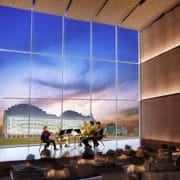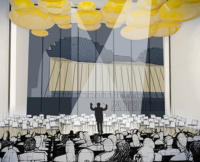Downtown site proposed for UMKC Conservatory
In what is being hailed as a critical boost toward moving the UMKC Conservatory of Music and Dance to Downtown Kansas City, supporters have obtained an entire city block immediately south of the Kauffman Center for the Performing Arts.
The Kansas City Star reported the news on Sunday. Reporter Kevin Collison wrote:
The acquisition of the block southeast of 17th Street and Broadway by anonymous donors, a “group of angels” according to university officials, is a key real estate accomplishment for the project. But it will also help with the completion of fundraising.
UMKC officials say that between the $6 million donation of the land and the previous major pledges, they’ve raised $27 million toward a goal of $48 million in private donations. At that point, the university will ask state lawmakers to come through with matching funds for the $96 million conservatory plan.
“The next set of donors want to see what they’re buying here, what they’re investing in,” said Leo Morton, chancellor of the University of Missouri-Kansas City. “This will move this project forward.”
A formal announcement of the block that was purchased is scheduled for 8 a.m. Monday morning at the Kauffman Center for the Performing Arts.
The eventual move of the conservatory and its 620 students and 110 faculty to the site is also considered a strategic opportunity to further redevelopment in the Crossroads Arts District, and to reinforce the connection between the central business district and Crown Center, a longtime goal of downtown advocates.
“I know of no more strategic corner that we could be able to put together,” said Phil Kirk Jr., former chairman of DST Realty and an urban strategist who helped assemble the site.
“It took a group of donors, interested in the arts and education, willing to step forward to make this possible.”
Supporters of relocating the conservatory next to the Kauffman Center believe it would be a great artistic marriage. They point to a similar relationship between the Juilliard School and Lincoln Center in New York, and the New England Conservatory and Jordan Hall in Boston.
“That’s the ecosystem students will create their careers in,” said Peter Witte, dean of the conservatory.
Sean O’Byrne of the Downtown Council, which also helped assemble the property, pointed out that students at the conservatory will have a clear view of the grand glass atrium of the Kauffman Center.
“Students will be actually able to look up to this shiny icon on the hill and know someday they will be performing there,” he said.
The proposed relocation of the conservatory, first reported by The Star three years ago, received its initial major donation a year ago when the Muriel McBrien Kauffman Foundation, led by Julia Irene Kauffman, announced a $20 million challenge pledge. It joined a previous $1 million anonymous donation.
At the time the challenge pledge was made, however, two locations were being considered for the conservatory, both near the Kauffman Center, and no additional donations have been announced since then.
UMKC officials believe having a site identified and acquired will galvanize fundraising. The clock also is ticking on the Kauffman challenge, which has a three-year deadline.
“We’ve had a number of conversations with potential donors,” Morton said. “To have a solid site and eventually renderings will help us advance the cause.”
Assembling the block for the conservatory proved relatively easy, according to O’Byrne and Kirk.
The four property owners were amenable to selling, particularly because of its intended use. The properties are a building at 1701 Broadway, a school formerly operated by the Guadalupe Center at 1711 Broadway, a building at 315 W. 17th St. and a building at 1711 Central St.
“In my 20 years of commercial real estate, I’ve never been involved in such a wonderful transaction,” O’Byrne said. “Everybody was reasonable.”
The plan calls for the existing buildings, none of which is historically significant, to be demolished and replaced with a 190,000-square-foot conservatory building. The low-rise structure would include classroom and rehearsal space.
An architect has not been chosen, although Helix Architecture & Design has assisted in the planning.
The block will be controlled by an entity established by the Downtown Council called Block 4 Acquisitions. It would be transferred to UMKC once the university obtains the necessary funding. If the conservatory plan falls through, the buildings would still be cleared and the site made available for other development.
Another big advantage of the block chosen for the proposed conservatory is ample, nearby parking. It’s across 17th Street from the 1,000-space parking garage built by the city for the Kauffman Center.
City officials say the Arts District Garage is mostly empty when there are no performances. It is open to the public — and students — for $3 daily during day hours and $55 per month.
Opportunities also exist for development and redevelopment, including potential housing for students.
The block acquired for the conservatory borders a community garden and environmental showcase to the south called 18Broadway. The space was established by DST Realty in 2010 on the site of a proposed highrise condominium. After that project failed, DST essentially put the land on hold as a green oasis until another development opportunity arose.
Kirk said that DST land could be ultimately developed for future phases of what UMKC is calling its Downtown Campus of the Arts, or other associated development.
Jane Chu, president and CEO of the Kauffman Center, described the acquisition of the property as an “exponential” move for the conservatory proposal.
“Not only does it benefit that project but it sparks creativity for all the areas around it, including the performing arts center,” she said.
In 2011, the state approved legislation intended to match private dollars for university capital improvement projects, but no money has been allocated.
“I don’t see this funding path being more difficult than other projects,” Morton said. “It is up to us to get the private money in place.”



